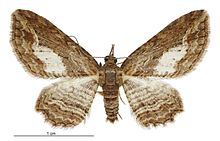| Submission declined on 1 July 2024 by DoubleGrazing (talk). Thank you for your submission, but the subject of this article already exists in Wikipedia. You can find it and improve it at Chloroclystis filata instead.
Where to get help
How to improve a draft
You can also browse Wikipedia:Featured articles and Wikipedia:Good articles to find examples of Wikipedia's best writing on topics similar to your proposed article. Improving your odds of a speedy review To improve your odds of a faster review, tag your draft with relevant WikiProject tags using the button below. This will let reviewers know a new draft has been submitted in their area of interest. For instance, if you wrote about a female astronomer, you would want to add the Biography, Astronomy, and Women scientists tags. Editor resources
|  |
| Chloroclystis filata | |
|---|---|

| |
| Male specimen | |

| |
| Female specimen | |
| Scientific classification | |
| Domain: | Eukaryota |
| Kingdom: | Animalia |
| Phylum: | Arthropoda |
| Class: | Insecta |
| Order: | Lepidoptera |
| Family: | Geometridae |
| Genus: | Chloroclystis |
| Species: | C. filata
|
| Binomial name | |
| Chloroclystis filata | |
| Synonyms | |
| |
Chloroclystis filata have a broad hammer shaped head (Holloway, et al, 1987). Their forewings span about 9mm up to 13mm (B. & Ball, 2023) and are marked with narrow transverse fasciae. The fasciae meet at the dorsum and a right angle. The middle of the wing is broad and tends to be darker than the wings. The postmedial and antemedial fasciae are unmarked and have a dark discal dash. On both sides of the medial zone is a pale zone which then goes to finer details. At the edge of both fore and hind wings are fringes. The hindwings are very uniform and have a similar pattern to Asthena Hübner. The male C. Filata have coremata in the abdomen that can be turned inside out. Males' genitalia have the transtilla divided into dorsal and ventral structures. The larvae have well developed prolegs on the abdominal. Only being on segment 6 and 10. They have small to medium slender bodies. They have been found to sometimes have multiple secondary setae (Holloway, et al, 1987)[2] The eggs are slightly to heavily sculptured and smooth. They oblong and tend to have a flattened side (Scoble, 1992).[3]
Geographic distribution and habitat
editNatural global range -
The Filata moth is Native to Australia but is thought to naturally immigrated to New Zealand (B. & Ball, 2023).[4]
New Zealand range -
They were first found in New Zealand in 1960. These pug moths are common all-around New Zealand (B. & Ball, 2023).[5]
Habitat preferences
editThey are found in environments like waste places, parks and shrublands. They are mostly found during the night times and tend to come towards light. Adults are found throughout the year (B. & Ball, 2023).[6]
Life cycle/phenology
editThe Filata Moths starts its life as an egg. The egg is always flat with one end wider than the other, sometimes concaved, or smooth. They tend to be either quite pale or spotted. They also are either lying by themselves or in small groups. Onces, it has hatched from the egg it becomes a Larva. This larva is long and skinny in shape. But as they mature, they grow thicker in shape. Their heads are round and hypognathous. This may change overtime and become pointed (Common, 2011). After they pupae has hatched, they immediately start mating and soon lay their eggs (Scoble, 1992).[7]
Diet / prey / predators
editDiet and foraging - The Lavae feed off the flowers of plants like gorse and senecio (B. & Ball, 2023).[8] The larvae are also know to feed on twiggy bush-pea, eating its buds and leaves. The Australian pug moth is also known for feeding on Plantaginaceae, which consist of plants like snapdragons and other flowering plants. Another plant they enjoy is Fabaceae which is more shrublike (Schmidt, 2016).[9]
Predators, Parasites, and Diseases - The Predators of C.Filata are several different species of long-tailed bats (Ling, Tempero, & Schamhart, 2023).[10]
References
edit- ^ Yu, Dicky Sick Ki. "Chloroclystis filata (Guenee 1857)". Home of Ichneumonoidea. Taxapad. Archived from the original on 25 March 2016. Retrieved 25 January 2017.
- ^ Holloway, J; Bradley, J; Carter, D; Betts, C (1987). CIE Guides to Insects of Importance to Man 1: Lepidoptera. CABI. p. 207-. ISBN 9780851985947.
{{cite book}}: More than one of|pages=and|page=specified (help) - ^ Scoble, M. J. (1992). The lepidoptera: form, function, and diversity. Oxford; New York: Oxford University Press. ISBN 978-0-19-854031-1.
- ^ Hoare, Robert; Ball, Oliver (9 February 2023). A Photographic Guide to Moths & Butterflies of New Zealand. Upstart Press LTD | White cloud books. ISBN 9781776940035.
- ^ Hoare, Robert; Ball, Oliver (9 February 2023). A Photographic Guide to Moths & Butterflies of New Zealand. Upstart Press LTD | White cloud books. ISBN 9781776940035.
- ^ Hoare, Robert; Ball, Oliver (9 February 2023). A Photographic Guide to Moths & Butterflies of New Zealand. Upstart Press LTD | White cloud books. ISBN 9781776940035.
- ^ Scoble, M. J. (1992). The lepidoptera: form, function, and diversity. Oxford ; New York: Oxford University Press. ISBN 978-0-19-854031-1.
- ^ Hoare, Robert; Ball, Oliver (9 February 2023). A Photographic Guide to Moths & Butterflies of New Zealand. Upstart Press LTD | White cloud books. ISBN 9781776940035.
- ^ Schmidt, Olga (21 March 2016). "Larval food plants of Australian Larentiinae (Lepidoptera: Geometridae) - a review of available data". Biodiversity Data Journal. 4 (4): e7938. doi:10.3897/bdj.4.e7938. PMC 4822076. PMID 27099558.
- ^ Ling, Nicholas; Tempero, Grant W.; Schamhart, Titia (13 August 2023). "Using faecal DNA metabarcoding to determine the diet of the long-tailed bat, Chalinolobus tuberculatus". New Zealand Journal of Zoology: 1–8. doi:10.1080/03014223.2023.2240711.